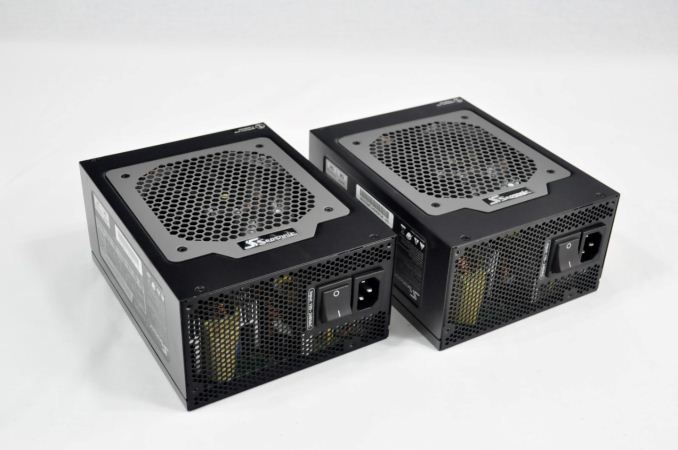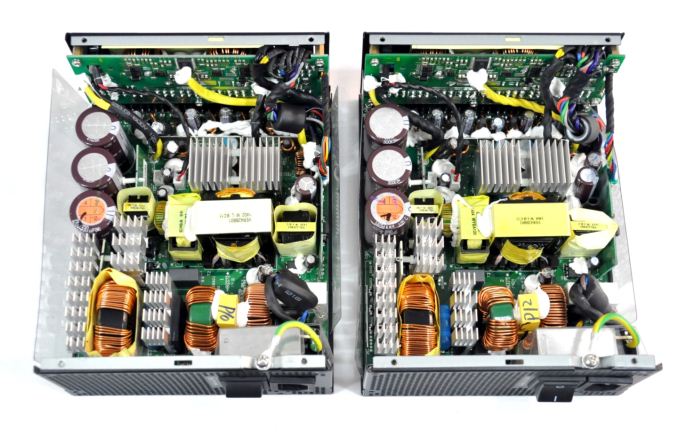Seasonic Platinum SS-1050XP3 & SS-1200XP3 Power Supply Review
by E. Fylladitakis on September 3, 2014 6:00 PM EST- Posted in
- Cases/Cooling/PSUs
- Seasonic
- 1200W
- 80Plus Platinum
- 1050W
External Appearance
Externally, both units are nearly identical, with the sole exception being the sticker with the specifications table on the left side of the chassis. The 190mm long chassis will most likely be too long for small cases, but these units are definitely not designed for compact systems. Seasonic's designs usually are subtle but the company has performed several modifications to enhance the aesthetic value of their top-tier units.
The circular fan guard has been replaced with a rectangular grey panel, with a honeycomb mesh pattern and a badge with the company logo on it. Seasonic added decorative engravings and printed the company and series logos on the right side of the chassis, where they will most likely be invisible, as they will be facing the right side panel of most cases. For these engravings to be visible from a windowed left side panel, the PSU will have to be installed with the fan facing upwards. If the fan is facing downwards, the decorations will also be upside down, so they are best left out of sight. On the left side of the chassis, the side that is visible from windowed side panels, Seasonic placed a sticker with the specifications of the PSU.
A typical C14 receptacle can be seen at the perforated rear side of the units, next to a large on/off switch. The front of the units is filled with connectors for the modular cables and there also is a switch that can change the fan's profile from normal to hybrid mode. The hybrid mode is a quieter thermal profile and allows the fan to be turned off entirely when it's not necessary. Finally, the company and series logos are printed here as well.
Internal Design
Seasonic went with a San Ace 9S1212H403 120mm fan in both of their newest models. It is a very powerful fan, with a top rated speed of 2700RPM. The specifications of the bearing/engine are not available from the manufacturer, but it looks like Sanyo uses a form of self-lubricating sleeve bearing. The life expectancy of this fan is 40,000 hours, a rather mediocre rating for similar devices, but it also translates to about 4.5 years of 24/7 use at 60°C, albeit this rating also is for a free, unobstructed air path (zero static pressure, max airflow).
Seasonic designs and builds their own units so there is no secondary / hidden OEM behind their Platinum series; these PSUs are entirely in-house productions. Both units share the exact same platform and design, with the obvious difference being only the ratings of both the passive and active components. For example, the 1050W version has three Nippon Chemi-Con 330μF capacitors at the PFC stage, whereas the 1200W version has three 390μF capacitors of the same type installed there. Aside from the component ratings however, the two versions do not have a discernible design difference.
The filtering components at the back of the AC receptacle are shielded in an effort to reduce EMI. The total number of filtering components is six Y capacitors, four X capacitors, and three filtering inductors, more than adequate for a strong filtering stage, even for units of this size. Moving towards the APFC stage, we can see the two bridge rectifiers on their own small heatsink, followed by a sizable APFC coil and three capacitors from Nippon Chemi-Con.
The active PFC components are on the long heatsink near the edge of the PCB, while the smaller heatsink towards the center of the unit holds the four transistors that form the full-bridge inversion stage. Two square heatsinks cool the active components of the secondary conversion stage, which are not directly attached to the heatsinks but are on the rear of the PCB. Nippon Chemi-Con supplies all of the secondary side capacitors as well, electrolytic and solid alike, making these units an all-Japanese affair.
When it comes to build quality, Seasonic has an excellent reputation for designing and building top-quality products; these two units however surprised us. Seasonic is definitely using top-tier components, some of the best that can be found in a consumer-grade product. The soldering job is excellent as well and we could not find a single bad joint or weak point. What confounded us however is that the assembly of the Platinum units is rather messy, which is a first for Seasonic.
It is not bad, not even average, but it does not live up to the standards Seasonic themselves have set. There are cables pressing against components and many electrolytic capacitors appear to have received mechanical force after they have been soldered on the board, tilting them left and right. Even the glue appears to have been spilt carelessly and purposelessly, as there are spots where it does not even touch the components it is supposed to. If this was true for just one sample, we could consider the possibility of it being an "isolated case", but both of the samples that we received share these flaws, so it is not random. Perhaps these are just pre-production or early samples, and we hope so, but we've seen better attention to detail in previous Seasonic units.

























39 Comments
View All Comments
ijozic - Thursday, September 4, 2014 - link
It sounds like it would cost noticeably more for something most people PROBABLY won't really care about. And the market is already quite competitive..Samus - Thursday, September 4, 2014 - link
The only complicated factor is space inside the standard ATX housing, but considering there are 500-watt 80+ Gold SFX PSU's that are 1/3rd the size of ATX, making a 100-watt primary stage with a 1000-watt secondary stage shouldn't be impossible. The most expensive part would likely be the cap for the relay (1/4 farad) and obviously that cap is going to be pretty large, most electrolytic caps this size are around 5" long.I think the BOM would be ~$20, and engineering it in isn't rocket science. This could totally be done, and if I were paying $200+ for a PSU, I'd expect some level of engineering beyond a good bridge design and PFC.
jann5s - Thursday, September 4, 2014 - link
have a look at the pico-PSU, these go up to 160W and are approximately the size of the ATX-plug attached to the umbilical coard of your PSU, this will definately fit.DanNeely - Thursday, September 4, 2014 - link
With a picoPSU you need to look at not just the 12V to 3.3/5V (smaller models) or 19V to 12/5/3.3V circuitry on the ATX plug; but the size of the external power brick used to feed it. It's still probably feasible volumetrically, but isn't nearly as much of a gimmie as just looking at the size of the ATX plug module implies.DanNeely - Thursday, September 4, 2014 - link
... especially since this could potentially be done by beefing up the existing Vsb circuit instead of adding something entirely new. JonnyGuru's testing shows current Vsb implementations aren't particularly impressive at only around 80%; but depending on how much worse current models perform below 10% some gains might still be reasonable. With the Titanium spec mandating 90% efficiency at 10% load though I'm not sure it's really worth it. On the 300-700W units that are suitable for ~90% of enthusiast systems 10% of rated power is generally enough to cover idle loads as long as you don't do anything silly (eg running an IGP powered low power mITX board with an SLI capable PSU). OTOH idle loads are steadily improving with each new CPU/GPU generation and the 80+ group will need to extend the standard to be tougher somewhere for whatever comes after titanium.TelstarTOS - Thursday, September 4, 2014 - link
I totally agree. What's holding me to get a 1000W+ PSU is the efficiency at low loads. With CPUs getting more and more green, PSUs should do the same and not only when under full load (which is a countersense if you really think about it).DanNeely - Thursday, September 4, 2014 - link
More attention is being paid to lower end efficiency than in the past; and this PSU is a prime example. While it falls short of the (new) 90% efficient at 10% load requirement for 80+ titantium, it's ~89% efficiency is much better than any of the other PSUs reviewed earlier this year did; none of which did better than the low to mid 80's at that level.Phillip Wager - Monday, September 8, 2014 - link
i like the dual stage idea but i am assuming most consumers are not willing to pay more for additional cost/complexity because that small amount of power that you are wasting turns out to be a very small amount of money over the lifetime of the system. I am somewhat suprised with your test results with your system because my computer has nearly identical specs and i have a 600 watt power supply and i have never had so much as a hiccup. Maybe get a different device for measuring power draw or perhaps your power supply is not as inefficient as you think.bsim500 - Thursday, September 4, 2014 - link
I agree, but there's not much you can do. It's the nature of high-wattage PSU's. If they came out with a 95% efficient "super platinum" PSU, lower wattage PSU's would adopt the same technology and the "idle gap" would still remain.Personally, I have a Seasonic G360 (yes, 360W PSU) that perfectly feeds an i5 + 7870 GFX card, and pulls (measured at the wall) : 182w peak Prime + Furmark / 110-150w typical gaming load / 88w 4T Prime or X264 encode load (CPU only) and 37w idle (which falls to 26w if discrete GFX card is removed, and that's with 1600MHz Ivy Bridge idle, not 800MHz Haswell), never pulling more than 50% PSU draw even under combined synthetic CPU+GPU "power viruses", and spending 90% of its time at +90% PSU efficiency with a virtually silent fan.
That 26-37w idle wattage on these PSU's is barely 50-60% efficiency level, yet the number of people who "swear" they "need" a 1200w PSU just for a single mid-range dGPU gaming rig is quite comical. ;-)
Samus - Thursday, September 4, 2014 - link
I know, "right sizing' a PSU is something few people understand. The worst thing you could do to your wallet is spend a fortune on a 600+ watt PSU and spend another fortune paying for it to inefficiently idle over the years for that i5 with integrated graphics and a single hard disk...